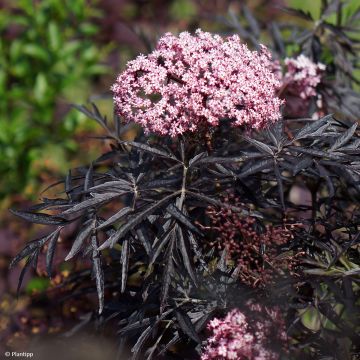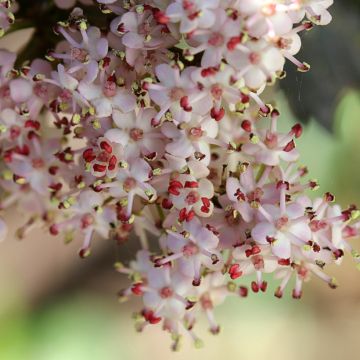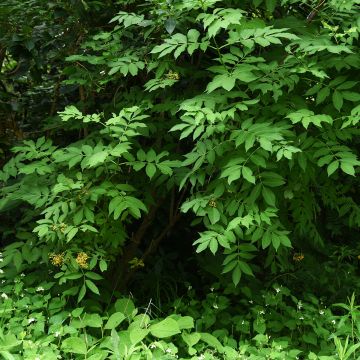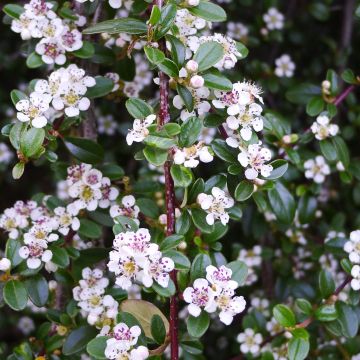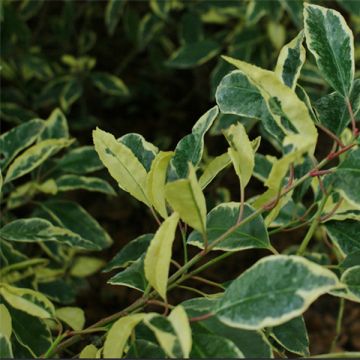

Sambucus nigra Blue Sheen - Elder
Sambucus nigra Blue Sheen - Elder
Sambucus nigra f. porphyrophylla Blue Sheen ('Hyfsheen')
Elder, Black Elder, European Elder, Elderberry
Special offer!
Receive a €20 voucher for any order over €90 (excluding delivery costs, credit notes, and plastic-free options)!
1- Add your favorite plants to your cart.
2- Once you have reached €90, confirm your order (you can even choose the delivery date!).
3- As soon as your order is shipped, you will receive an email containing your voucher code, valid for 3 months (90 days).
Your voucher is unique and can only be used once, for any order with a minimum value of €20, excluding delivery costs.
Can be combined with other current offers, non-divisible and non-refundable.
Home or relay delivery (depending on size and destination)
Schedule delivery date,
and select date in basket
This plant carries a 24 months recovery warranty
More information
We guarantee the quality of our plants for a full growing cycle, and will replace at our expense any plant that fails to recover under normal climatic and planting conditions.
Would this plant suit my garden?
Set up your Plantfit profile →
Description
Sambucus nigra 'Blue Sheen' is a variety of black elderberry that stands out for its dark foliage that takes on magnificent blue and silver reflections in full light. It is a large bush with a rather slender habit, with cut foliage and delicate pink summer flowering that stands out well against richly coloured vegetation. It also produces clusters of small edible black berries. A superb plant, perfectly hardy, undemanding and almost maintenance-free.
Sambucus nigra f.porphyrophylla 'Blue Sheen' ('Hyfsheen') is a deciduous shrub from the Adoxaceae family. It is a horticultural selection. Its wild ancestor, Sambucus nigra, is widespread in Europe, North Africa, and as far as Asia Minor. Black elderberry is an opportunistic and highly adaptable species, found in open woods, hedges, fallow land, coastal dunes, and even near human settlements where it has coexisted for millennia. It is an undemanding shrub that is really easy to grow everywhere. It tolerates clay-limestone soils perfectly, even relatively dry ones if they are deep.
The 'Blue Sheen' cultivar, with its rapid growth, reaches a height of up to 4 m with a spread of 2-3 m. Its habit is bushy and upright. Its woody branches are verrucate, greyish and filled with white pith. They bear particularly ornamental foliage; its leaves are divided into ovate and toothed leaflets that change colour throughout the seasons, while retaining a silver-blue shine in full light. In spring, the young leaves are reddish-purple, they turn darker red to reddish-brown in summer and autumn before falling. Flowering usually occurs in June (a little earlier or later depending on the climate). It takes the form of false umbels measuring 10 to 12 cm in diameter that remain decorative for a long time. Each umbel consists of numerous tiny 5-petaled flowers. Over time, these flowers change from cherry pink to pinkish-white, creating a delightful range of colours on the shrub. This slightly fragrant flowering attracts many pollinating insects. The fruits, edible once cooked, are black to purplish berries with soft flesh, measuring 6 mm in diameter.
'Blue Sheen' elderberry is a beautiful shrub for a large flowering hedge, but it also looks great when planted as a standalone specimen, at the corner of a path, or the front of a large shrub bed. Like all elderberries, it is robust and easy to combine with other flowering shrubs. For example, it can be associated with hedge lilacs, Viburnum opulus 'Roseum' (Snowball Viburnum), the vigorous 'Richmond' sacred bamboo, Hydrangea paniculata 'Limelight' (Panicle Hydrangea), or even weigelas for hedges, with their impressive stature.
In the kitchen: the flowers can be prepared in fritters or syrup by macerating them in sugar. The buds in vinegar are used to enhance salads, and the berries are consumed in juice, jellies or jams, or in wine. They add a pleasant fragrance to apple cakes. Only the flowers and berries without their petioles are edible, the rest of the plant can be toxic.
Good to know: elderberry leaves are known to speed up compost decomposition. Black elderberry leaf infusion can be useful in organic gardening to fight against mildew and attacks from aphids or rodents. Soak 1 kg of leaves in 10 L of water for a few days, and spray as needed. It can also be planted in an orchard, where it attracts insect-eating birds.
Plant habit
Flowering
Foliage
Botanical data
Sambucus
nigra f. porphyrophylla
Blue Sheen ('Hyfsheen')
Caprifoliaceae
Elder, Black Elder, European Elder, Elderberry
Sambucus nigra f. porphyrophylla Blue Sheen ('Hyfsheen')
Cultivar or hybrid
Other Sambucus - Elder tree
View all →Planting and care
The easy to grow, 'Blue Sheen' Black Elderberry is best planted in the autumn to benefit from rainfall, or in the spring, but it will then require more watering until the end of summer. Plant it in any fairly fertile and deep soil, properly drained. Once well-rooted, this bush tolerates periods of drought quite well. Choose a sunny or semi-shaded location, and dig a planting hole at least 50 cm on all sides. Soak the root ball in a bucket of water for fifteen minutes (until fully saturated). Mix planting compost with the existing soil, position the root ball so that the top is level with the ground, fill in the hole and water generously. Water regularly during the first 2 years to promote root growth, and then during hot periods.
Planting period
Intended location
Care
Planting & care advice
This item has not been reviewed yet - be the first to leave a review about it.
Similar products
Haven't found what you were looking for?
Hardiness is the lowest winter temperature a plant can endure without suffering serious damage or even dying. However, hardiness is affected by location (a sheltered area, such as a patio), protection (winter cover) and soil type (hardiness is improved by well-drained soil).

Photo Sharing Terms & Conditions
In order to encourage gardeners to interact and share their experiences, Promesse de fleurs offers various media enabling content to be uploaded onto its Site - in particular via the ‘Photo sharing’ module.
The User agrees to refrain from:
- Posting any content that is illegal, prejudicial, insulting, racist, inciteful to hatred, revisionist, contrary to public decency, that infringes on privacy or on the privacy rights of third parties, in particular the publicity rights of persons and goods, intellectual property rights, or the right to privacy.
- Submitting content on behalf of a third party;
- Impersonate the identity of a third party and/or publish any personal information about a third party;
In general, the User undertakes to refrain from any unethical behaviour.
All Content (in particular text, comments, files, images, photos, videos, creative works, etc.), which may be subject to property or intellectual property rights, image or other private rights, shall remain the property of the User, subject to the limited rights granted by the terms of the licence granted by Promesse de fleurs as stated below. Users are at liberty to publish or not to publish such Content on the Site, notably via the ‘Photo Sharing’ facility, and accept that this Content shall be made public and freely accessible, notably on the Internet.
Users further acknowledge, undertake to have ,and guarantee that they hold all necessary rights and permissions to publish such material on the Site, in particular with regard to the legislation in force pertaining to any privacy, property, intellectual property, image, or contractual rights, or rights of any other nature. By publishing such Content on the Site, Users acknowledge accepting full liability as publishers of the Content within the meaning of the law, and grant Promesse de fleurs, free of charge, an inclusive, worldwide licence for the said Content for the entire duration of its publication, including all reproduction, representation, up/downloading, displaying, performing, transmission, and storage rights.
Users also grant permission for their name to be linked to the Content and accept that this link may not always be made available.
By engaging in posting material, Users consent to their Content becoming automatically accessible on the Internet, in particular on other sites and/or blogs and/or web pages of the Promesse de fleurs site, including in particular social pages and the Promesse de fleurs catalogue.
Users may secure the removal of entrusted content free of charge by issuing a simple request via our contact form.
The flowering period indicated on our website applies to countries and regions located in USDA zone 8 (France, the United Kingdom, Ireland, the Netherlands, etc.)
It will vary according to where you live:
- In zones 9 to 10 (Italy, Spain, Greece, etc.), flowering will occur about 2 to 4 weeks earlier.
- In zones 6 to 7 (Germany, Poland, Slovenia, and lower mountainous regions), flowering will be delayed by 2 to 3 weeks.
- In zone 5 (Central Europe, Scandinavia), blooming will be delayed by 3 to 5 weeks.
In temperate climates, pruning of spring-flowering shrubs (forsythia, spireas, etc.) should be done just after flowering.
Pruning of summer-flowering shrubs (Indian Lilac, Perovskia, etc.) can be done in winter or spring.
In cold regions as well as with frost-sensitive plants, avoid pruning too early when severe frosts may still occur.
The planting period indicated on our website applies to countries and regions located in USDA zone 8 (France, United Kingdom, Ireland, Netherlands).
It will vary according to where you live:
- In Mediterranean zones (Marseille, Madrid, Milan, etc.), autumn and winter are the best planting periods.
- In continental zones (Strasbourg, Munich, Vienna, etc.), delay planting by 2 to 3 weeks in spring and bring it forward by 2 to 4 weeks in autumn.
- In mountainous regions (the Alps, Pyrenees, Carpathians, etc.), it is best to plant in late spring (May-June) or late summer (August-September).
The harvesting period indicated on our website applies to countries and regions in USDA zone 8 (France, England, Ireland, the Netherlands).
In colder areas (Scandinavia, Poland, Austria...) fruit and vegetable harvests are likely to be delayed by 3-4 weeks.
In warmer areas (Italy, Spain, Greece, etc.), harvesting will probably take place earlier, depending on weather conditions.
The sowing periods indicated on our website apply to countries and regions within USDA Zone 8 (France, UK, Ireland, Netherlands).
In colder areas (Scandinavia, Poland, Austria...), delay any outdoor sowing by 3-4 weeks, or sow under glass.
In warmer climes (Italy, Spain, Greece, etc.), bring outdoor sowing forward by a few weeks.




































